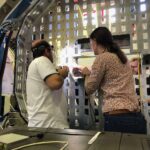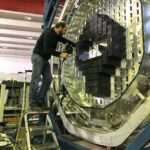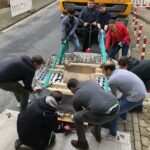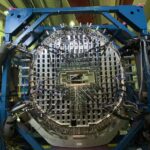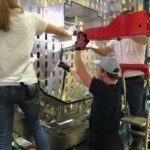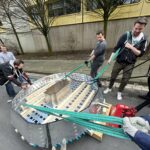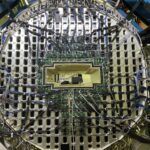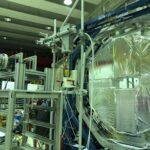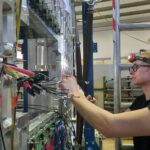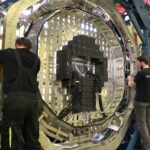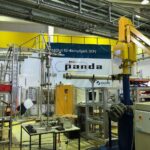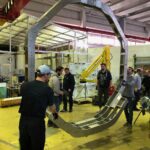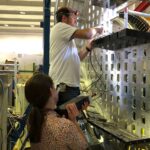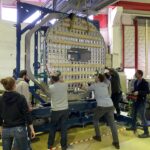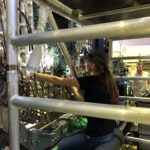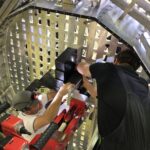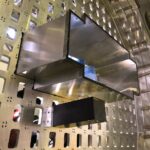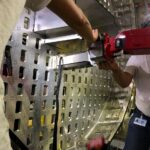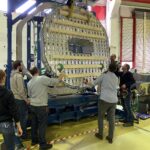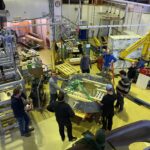Particle detectors are the essential tools for physicists to study the properties and interactions of the smallest building blocks of matter in our universe. A next generation particle physics detector will be the PANDA detector.
Article by Christopher Wenzel, EP1
The PANDA experiment will study one of the fundamental forces of nature, the strong interaction, in reactions where anti-matter and matter annihilate. Antiproton Proton reactions, (p̅p)-reactions, at the future international research facility FAIR located in Darmstadt will for example be used to investigate the complex bound states of the strong interaction and to search for exotic states. The forward endcap of the electromagnetic calorimeter (FWEC) is an essential part of the PANDA detector and is used to measure the energy of electrons, positrons and photons with very good resolution
How is such a calorimeter set-up and how is it put into operation?
These questions can be answered by the members of the research groups of Prof. Ulrich Wiedner in Bochum and Prof. Ulrike Thoma in Bonn. Both groups together successfully assembled and tested the FWEC during two test-beam times at the proton accelerator COSY at Forschungszentrum Jülich in the second half of 2023. In mid-March, the first step was made transporting the support structure of the FWEC from Bochum to Jülich. Four cranes were needed to move the circularly shaped support-structure with a diameter of 2.5 m and a weight of 350 kg to its interim destination at COSY. In Figure1 and the photo gallery you can see a snapshot of this spectacular event.
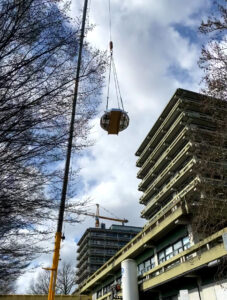
Figure 1: Lifted FWEC support structure at Ruhr-Universität Bochum
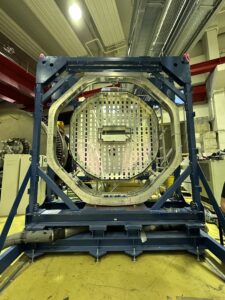
Fig 2: Installed support structure of the FWEC at COSY
After arriving at Forschungszentrum Jülich, it was mounted within a massive transport frame, holding the FWEC in an upright position and preventing it from tilting. Several ground anchors were used to secure it, even in the case of small earth quakes. In a second step the support structure had to be equipped with the detector modules. Each module consists of 16 or 8 scintillation crystals made of lead tungstate with a photodetector attached.
An incident particle deposits energy within the crystals and the energy is converted into light. This is detected via an attached photodetector that generates an electrical signal, which can be processed with further readout electronics. As the signal output is proportional to the deposited energy, the energy of the incident particle can be reconstructed.
The design and assembly of the electromagnetic calorimeter is a truly international endeavor. The crystals were tested at the University of Gießen and CERN (Geneva, Switzerland), the photodetectors were tested at the Universities of Bochum and Bonn, as well as at GSI, (Darmstadt), the preamplifiers were designed and produced at the University of Basel (Switzerland), the mechanics were designed at the University of Groningen (Netherlands), the cooling system was designed at Orsay (France), digitization electronics were developed at and provided by the University of Uppsala (Sweden).
The picture below illustrates assembled modules on the left as well as the single components on the right and printed circuit boards readout boards in the front. The, at the University of Bochum, assembled detector modules were tested and pre-calibrated at the University of Bonn, at their later operation temperature of -25°C to ensure proper functionality.
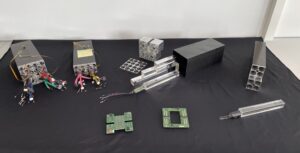
Figure 3: FWEC detector modules, their components and the electronic board for photodetector-HV-adjustment as well as the patch panel board
The excellent collaboration between Bochum and Bonn, finally payed off in the joint detector mounting in Jülich. In total 60 detector modules with 864 crystals were mounted and equipped with the necessary front-end electronics and cables. As the whole calorimeter must be operated at freezing -25°C, all parts were covered with insulation and a complex cooling system was installed to reach and maintain the targeted temperature. As condensation is a problem when running electronics at such cold temperatures, the FWEC was flushed with dry air and nitrogen. The different stages of the assembly are shown in the figures 4-6.
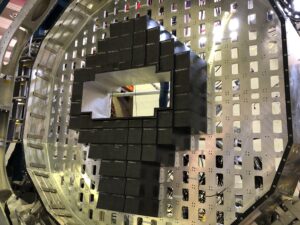
Figure 4: FWEC front with 60 mounted detector modules
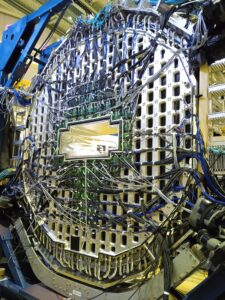
Figure 5: FWEC back with printed circuit boards and cables
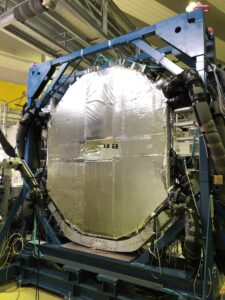
Figure 6: FWEC front, covered in insulation and connected cooling pipes
Remaining tasks were the installation of a detector control system to control the detector with all of its subsystems and the DAQ to read out and store the detector signals.
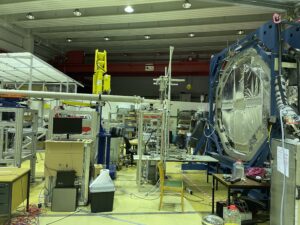
Figure 7: Setup of the FWEC for COSY beam
In July, the system with its 864 crystal units was finally put into operation for the first time at the proton beam of the COSY accelerator in Jülich. This first test was followed by two beam times in August and September. During these beamtimes high energetic particles, including π’s and η’s, were produced at the target in the proton beam. The produced particles or their decay products were then measured with the FWEC. With these efforts, one of the first detector components of the PANDA detector, the partially equipped FWEC, has started its operation and was carefully tested under beam conditions. Figure 7 shows the FWEC on the right, the proton beam pipe and target in between.
During the successful beam times 210 TB of data were recorded, which are currently being analyzed. They will be used to calibrate the detector, to study its performance in detail and to improve the software, needed to reconstruct the information on the particles detected in the FWEC. Over 15 years of careful research and hardware developments have led to this exciting moment of observing the first particles in our detector system. It is known by simulations that minimal ionizing particles deposit an energy of about 200MeV inside one crystal and we could confirm this prediction already at the beginning of our measurements. This energy deposition corresponds to an ADC-value of about 4000 depending on the individual amplification of each readout channel.
This is shown as an example for one of the crystals in Figure 8.
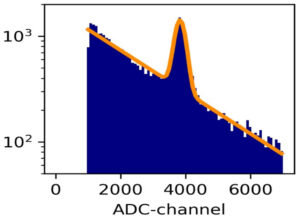
Figure 8: Energy spectrum showing minimum ionizing particles obtained with one crystal unit of the FWEC
The next stop in the journey of the FWEC will be the electron accelerator ELSA in Bonn. First the FWEC will be commissioned with all of its 268 detector modules (3856 crystals) and is then used for hadron physics experiments. At ELSA, photoproduction experiments will be performed using a polarized beam and target and the FWEC as forward calorimeter to study the emergence of complex bound states of the strong interaction made of up, down and strange quarks.
As soon as the antiproton beam is available at FAIR, the FWEC will finally be moved to Darmstadt to be part of the PANDA-Experiment. With the PANDA-Experiment new insights into strong interaction will be gained. This provides for interesting research especially for future generations of young scientists.
See further pictures in the photo gallery.



